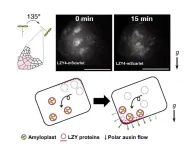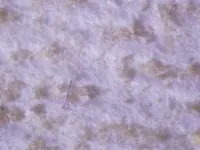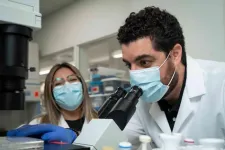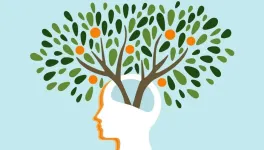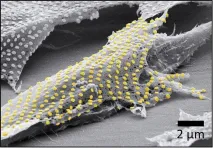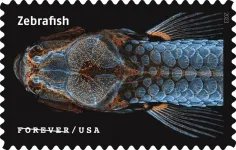(Press-News.org)
Plants orient their organs in response to the gravity vector, with roots growing towards gravity and shoots growing in the opposite direction. The movement of statoliths responding to the inclination relative to the gravity vector is employed for gravity sensing in both plants and animals. However, in plants, the statolith takes the form of a high-density organelle, known as an amyloplast, which settles toward gravity within the gravity sensing cell. Despite the significance of this gravity sensing mechanism, the exact process behind it has eluded scientists for over a century. A groundbreaking study led by Professor Miyo Terao Morita at the National Institute for Basic Biology (NIBB) in Japan has revealed that the translocation of signaling proteins from amyloplasts to the plasma membrane is the key to deciphering this enigmatic mechanism. The research, titled “ Cell polarity linked to gravity sensing is generated by LZY translocation from statoliths to the plasma membrane,” is now available online in Science ahead of print.
For years, researchers speculated on the gravity sensing mechanism, with hypotheses such as the force sensing model and position sensing hypothesis. However, definitive evidence for each remained elusive, until now. In their earlier work, the team discovered that Arabidopsis LAZY1-LIKE (LZY) proteins play a crucial role in gravity signal transduction, with polar localization at the plasma membrane on the side of gravity. Nevertheless, the exact mechanism establishing this remarkable localization remained unknown.
Through sophisticated live cell imaging techniques, including vertical stage microscopy and optical tweezers, the research team made a significant breakthrough. They found that LZYs not only localize at the plasma membrane near amyloplasts but also at the amyloplasts themselves. "The plasma membrane localization of LZYs surprised us, as it is generated by the close proximity of amyloplasts to the membrane," explained Takeshi Nishimura, Assistant Professor at NIBB and the first author of the study.
"We demonstrated that localization on both the plasma membrane and amyloplasts is necessary for gravity signaling in roots, indicating its fundamental role in this process," added Hiromasa Shikata, Assistant Professor at NIBB and the co-first author.
Professor Miyo Terao Morita further emphasized, "LZYs act as signal molecules, transmitting positional information from amyloplasts to the plasma membrane, where the regulation of auxin transport occurs." This revelation provides compelling support for the "position sensor hypothesis," explaining gravity sensing in plants through the proximity or the contact between statoliths and the plasma membrane.
LAZY1 was originally identified as the responsible gene for the rice gravitropism mutant. Its counterparts are conserved across various land plants, pinpointing their fundamental significance. The distinctive “lazy” phenotype, marked by the lateral spreading of branches and roots, has manifested in mutants of these genes in various plant species, including crops. Further studies on LZY may impact technology for controlling plant architecture and production.
###
Paper Information
Journal
Science
Authors
Takeshi Nishimura§, Shogo Mori §, Hiromasa Shikata§, Moritaka Nakamura, Yasuko Hashiguchi, Yoshinori Abe, Takuma Hagihara, Hiroshi Y. Yoshikawa, Masatsugu Toyota, Takumi Higaki, Miyo Terao Morita
§, these authors equally contributed to this work
END
LOS ANGELES — There are currently few effective treatment options for patients with recurrent ovarian cancer and other solid tumors, but City of Hope researchers are trying to change that.
Researchers with City of Hope, one of the largest cancer research and treatment organizations in the nation, have published preclinical research in Nature Communications demonstrating that a chimeric antigen receptor (CAR)-engineered T cell therapy worked against ovarian cancer in the laboratory and in preclinical models.
“City of Hope’s ...
SAN DIEGO (AUG. 10, 2023) — A new study on gray-necked rockfowl has found a much smaller range of suitable habitat for this elusive African bird than was previously assumed, and may warrant a downgrade in its conservation status.
Scientists from the Cameroon Biodiversity Association (CAMBIO) in Cameroon, in partnership with San Diego Zoo Wildlife Alliance, set out to better understand how much suitable habitat remains for the rockfowl, and where the birds can still be found.
Understanding suitable habitat and its extent is crucial for protecting species. However, scientists have limited knowledge ...
Physicians, psychologists, advanced practice providers, dietitians, and others who are committed to treating and preventing obesity in Louisiana have come together to formally launch the Louisiana Obesity Society, a new statewide professional organization. The Louisiana Obesity Society will be hosting its inaugural annual conference in conjunction with the Louisiana Chapter of American Society of Metabolic and Bariatric Surgery on Saturday, Aug. 12, at the Renaissance New Orleans Arts Warehouse District Hotel in New Orleans.
The Louisiana Obesity Society was created to support providers treating obesity through education and networking. The society will also advocate ...
Although millions are spent each year on entrepreneurship training that is intended to help alleviate poverty and elevate the quality of life of entrepreneurs in developing nations, these programs often fail to make an impact.
Brigham Young University professors Shad Morris and Chad Carlos, along with three other colleagues, were invited by the Tanzania Social Action Fund (“TASAF”) to see if they could help figure out why TASAF’s entrepreneurship trainings were not producing the results they were hoping for.
In order to assist TASAF, Morris, Carlos, and colleagues Geoff Kistruck, Elly Tumsifu and Bob Lount, carried out an extensive ...
For now, cyborgs exist only in fiction, but the concept is becoming more plausible as science progresses. And now, researchers are reporting in ACS’ Nano Letters that they have developed a proof-of-concept technique to “tattoo” living cells and tissues with flexible arrays of gold nanodots and nanowires. With further refinement, this method could eventually be used to integrate smart devices with living tissue for biomedical applications, such as bionics and biosensing.
Advances in electronics have enabled manufacturers ...
Long COVID can persist for at least a year after the acute illness has passed, or appear months later, according to the most comprehensive look yet at how symptoms play out over a year.
The multicenter study, a collaboration between UC San Francisco, the Centers for Disease Control and Prevention (CDC) and seven other sites, expands knowledge of post-COVID-19 conditions, describing trends in more detail than previous research and highlighting significant impacts the epidemic has had on the U.S. health care system.
The study appears Aug. 10, 2023, in Morbidity and Mortality Weekly Report (MMWR), ...
Open Access publisher PeerJ have announced their second Editor-in-Chief partnership for the Open Advances series of journals. Professors Ute Roessner and Luis E. Eguiarte have agreed to take on the leadership of PeerJ Open Advances in Plant Science as Co-Editors-in-Chief.
Professors Roessner and Eguiarte are highly respected, award-winning scientists working at the forefront of their fields. As Co-Editors-in-Chief they will provide the scientific leadership for the journal, starting with recruiting an Editorial Board who will ...
A microscopy image created by National Institutes of Health researchers is part of the “Life Magnified” stamp panel issued today by the United States Postal Service (USPS®). The NIH zebrafish image, which was taken to understand lymphatic vessel development in the brain, merges 350 individual images to reveal a juvenile zebrafish with a fluorescently tagged skull, scales and lymphatic system.
“Zebrafish are used as a model for typical and atypical human development. It is surprising how much we have in common with ...
Brazilian researchers combined environmental physical, social and economic indicators to create an index that measures a region’s vulnerability and used it to analyze the basins of the Parnaíba River and São Francisco River in the Northeast of Brazil. The index is named SEVI (for Socio-Environmental Vulnerability).
The Parnaíba and São Francisco basins are considered crucial to agricultural expansion and biodiversity conservation. They contain more than 780 municipalities and part of the semi-arid Caatinga and savanna-like Cerrado biomes, which are threatened ...
ROCHESTER, Minn. — Using human "mini-brain" models known as organoids, Mayo Clinic and Yale University scientists have discovered that the roots of autism spectrum disorder may be associated with an imbalance of specific neurons that play a critical role in how the brain communicates and functions. The specific cells are known as excitatory cortical neurons.
The new study is published in Nature Neuroscience.
Findings
The team found an abnormal imbalance of excitatory ...
